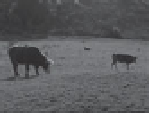Graphics Reference
In-Depth Information
algorithm and Poisson blending. This approach produces good results compared to
Criminisi's algorithm when the target region should contain continuations of struc-
tures to which the human eye is sensitive, such as horizon lines or fences. Komodakis
and Tziritas [
249
] took the belief-propagation approach a step further by applying it
to the entire target region instead of just the linear structures specified by the user.
While thismethod has the advantage of posing the problemglobally instead of greed-
ily selecting the best patch at each iteration, the main difficulty is managing the large
space of patch labels at each target position.
Finally, Hays and Efros [
191
] noted that the source region need not be confined
to the pixels in the image outside the target region. Instead, they proposed to use
millions
of photographs gathered from the Internet to suggest plausible completions
for a large target region, filling it with a large chunk from one of these images. These
plausible alternatives can vary widely, and the user is allowed to pick the best one for
his or her purpose. The main problem is devising a highly parallelizable algorithm to
efficiently search the huge database of images for good matches. Once each match-
ing image is aligned to the target image, a seam-based algorithm similar to that of
Section
3.3
is used to create the composite.
3.5
IMAGE RETARGETING AND RECOMPOSITING
Finally, we discuss
image retargeting
techniques for changing the size and aspect
ratio of an image. While many retargeting algorithms were designed for making an
image smaller (for example, to fit on a mobile device), these types of techniques
could also be used to reshape high-resolution images and video — for example, to
change a movie from the theater aspect ratio of 2.39:1 to the HDTV aspect ratio of
16:9. Common techniques for retargeting an image to a new aspect ratio include
cropping, scaling, and letterboxing, but as Figure
3.23
illustrates, these methods can
remove, distort, or shrink image features in perceptually distracting ways. However,
there has recently been an explosion of interest in the computer vision and graphics
communities in
content-aware image retargeting
. These methods resize an image
(a)
(b)
(c)
(d)
Figure 3.23.
Resizing an original image (a). (b) Cropping can remove important details from the
image (e.g., the second cow.) (c) Scaling changes the aspect ratio, causing unnatural distortions.
(d) Letterboxing makes all the elements of the image small, losing detail.







